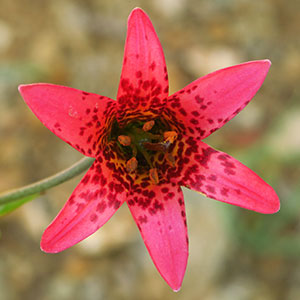Lilium bolanderi
Lilium maritimum
Bolander's lily
coast lily
± ovoid, 3.5–7.9 × 2.6–5.3 cm, 0.9–2.1 times taller than long;
scales unsegmented, longest 3–5.7 cm;
stem roots absent.
rhizomatous, often irregular, unbranched, continuously scaly, 1.8–4.1 × 3–7.4 cm, 0.3–0.9 times taller than long;
scales usually unsegmented, a few 2-segmented, longest 1.5–3.8 cm;
stem roots absent.
to 1.1 m, glaucous.
to 1.2(–2.3) m, plants on coastal bluffs shorter than 0.25 m. Buds rounded in cross section.
rounded in cross section.
in 1–5(–6) whorls or partial whorls, 3–19 leaves per whorl, ascending and often cupping stem, 1.8–7.1 × 0.7–2.8 cm, 2.2–4.8 times longer than wide;
blade ± obovate, oblanceolate, or occasionally elliptic, noticeably glaucous, margins nearly always undulate, apex widely acute;
veins and margins ± smooth abaxially.
sometimes concentrated proximally, scattered or usually in 1–3 whorls or partial whorls, 3–17 leaves per whorl, horizontal and drooping at tips to ascending, 3.6–17.7 × 0.3–4.7 cm, 2.4–18 times longer than wide;
blade elliptic, sometimes narrowly so, rarely weakly oblanceolate or obovate, margins not undulate, apex acute or narrowly so;
veins and margins ± smooth abaxially.
usually umbellate in small plants, in large plants racemose or in 2 whorls, 1–9-flowered.
racemose, 1–13-flowered.
nodding to horizontal, not fragrant;
perianth ± campanulate or funnelform;
sepals and petals somewhat recurved 3/5–4/5 along length from base, red or magenta, occasionally salmon pink or pale yellow, with maroon spots, often yellowish on proximal 1/3–1/2, not distinctly clawed;
sepals not ridged abaxially, 3.1–4.7 × 0.7–1.2 cm;
petals 3–4.5 × 0.7–1.1 cm;
stamens included;
filaments barely spreading, diverging 0°–12° from axis;
anthers reddish or magenta, 0.3–0.8 cm;
pollen rust, orange, or yellow;
pistil 2.1–3.5 cm;
ovary 1–2.1 cm;
style green, rarely reddish purple;
pedicel 0.8–14.2 cm.
nodding, rarely horizontal, not fragrant;
perianth campanulate;
sepals and petals reflexed or rolled 1/2–4/5 along length from base, red or red-orange, with maroon spots concentrated proximally along longitudinal median and surrounded by light orange or occasionally yellow-green, not distinctly clawed;
sepals not ridged abaxially, 3.4–5 × 0.9–1.3 cm;
petals 3.5–5 × 0.9–1.3 cm;
stamens included;
filaments somewhat spreading, diverging 3°–14° from axis;
anthers light magenta, 0.4–1.2 cm;
pollen orange;
pistil 2.2–3.2 cm;
ovary 1–1.8 cm;
style green;
pedicel 6.3–32 cm.
2–4.1 × 1.2–2.1 cm, 1.4–3 times longer than wide.
2.4–4.1 × 1.2–2 cm, 1.5–2.4 times longer than wide.
90–210.
120–237.
= 24.
= 24.
Lilium bolanderi
Lilium maritimum
I. M. Johnston (1923) noted that Lilium bolanderi Watson was based on a mixed collection including L. kelloggii, and he argued that Watson intended the name to apply primarily to the latter species. Thus he proposed the name L. howellii for this diminutive, red-flowered, serpentine endemic. A. D. Cotton (1936) correctly concluded that Watson’s description applied primarily to the specimens here called L. bolanderi, and this view is now widely accepted.
Lilium bolanderi hybridizes with L. rubescens, L. washingtonianum subsp. purpurascens, and subspecies of L. pardalinum.
Bolander’s lily is primarily pollinated by Allen’s and rufous hummingbirds (Selasphorus spp., family Trochilidae).
(Discussion copyrighted by Flora of North America; reprinted with permission.)
Of conservation concern.
Lilium maritimum is known in California from below San Francisco to about Westport in Mendocino County, and invariably grows within a few miles of the ocean. The coast lily has suffered grave declines in the past century and has been extirpated from the southern part of its range. The recent rediscovery of a population in Marin County at Point Reyes National Seashore is heartening, but development of coastal prairie farther north continues to be a threat.
The combination of nodding habit and campanulate perianth with rolled sepal and petal tips is unique among the North American lilies. Hybrids with Lilium pardalinum are known; these can be clonal and their flowers are morphologically intermediate between the parents.
Lilium maritimum is pollinated sequentially, first by Allen’s [Selasphorus sassin (Lesson), family Trochilidae] and Anna’s hummingbirds [Calypte anna (Lesson)], and later in the blooming cycle by several different bumblebees (Bombus Latrielle, family Apidae).
(Discussion copyrighted by Flora of North America; reprinted with permission.)


